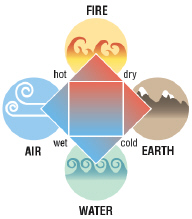Modified True/False True = A and False = B
Indicate whether the statement is true or false. If false,
change the identified word or phrase to make the statement true.
|
|
|
1.
|
An element cannot be broken down into simpler chemical substances by any
physical or chemical means.
|
|
|
2.
|
Metals generally have a shiny lustre.
|
|
|
3.
|
If an element is a gas at room temperature, it is likely to be a
metal.
|
|
|
4.
|
On the Periodic Table, the number of metallic elements is about the same
as the number of non-metallic elements.
|
|
|
5.
|
Elements in a column of the Periodic Table have similar
properties.
|
|
|
6.
|
Alkaline earth metals burn with bright, colourful flames.
|
|
|
7.
|
The diagram reflects what Democritus believed about the composition of
matter. 
|
|
|
8.
|
The ideas of the ancient Greek philosopher Aristotle about the structure
of matter were accepted for nearly 2000 years after his death.
|
|
|
9.
|
Experiments by J.J. Thomson showed that atoms contain electrons.
|
|
|
10.
|
If a negatively charged particle is attracted to a second particle, the second
particle must have a negative charge.
|
|
|
11.
|
Of protons, neutrons, and electrons, the least massive particle is the
electron.
|
|
|
12.
|
According to Bohr’s theory, the maximum number of electrons in each of the
first three orbits in atoms are respectively two, eight, and ten.
|
|
|
13.
|
The Bohr-Rutherford model of the atom is useful for explaining the properties of
all of the elements on the Periodic Table.
|
|
|
14.
|
An atom with 16 protons, 16 electrons and 18 neutrons has a mass number of
34.
|
|
|
15.
|
An aluminum atom with a mass number of 27 must contain 14
neutrons.
|
|
|
16.
|
Historians believe that many wealthy people in ancient Rome suffered from
copper poisoning.
|
|
|
17.
|
Iodine is an example of a halogen.
|
|
|
18.
|
Strontium is an example of an alkali metal.
|
|
|
19.
|
Xenon is an example of a noble gas.
|
|
|
20.
|
John Dalton was the first to propose the idea of indivisible
atoms.
|
|
|
21.
|
Diamond is the hardest form in which carbon occurs.
|